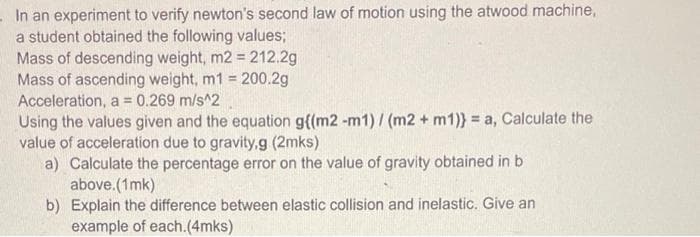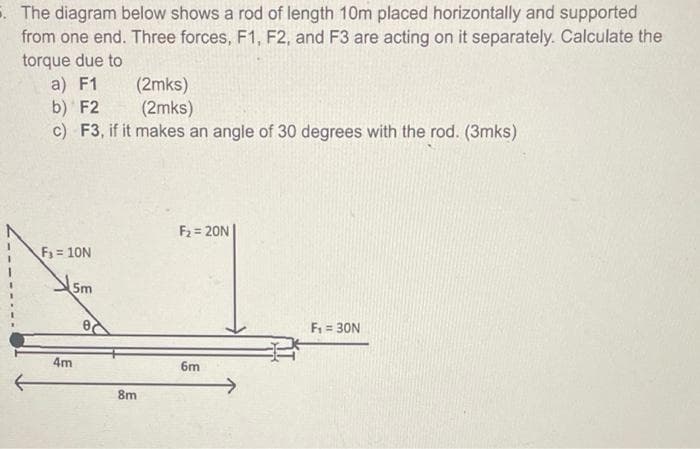-In an experiment to verify newton's second law of motion using the atwood machine, a student obtained the following values; Mass of descending weight, m2 = 212.2g Mass of ascending weight, m1 = 200.2g Acceleration, a = 0.269 m/s^2 Using the values given and the equation g{(m2 -m1)/ (m2 + m1)} = a, Calculate the value of acceleration due to gravity,g (2mks) a) Calculate the percentage error on the value of gravity obtained in b above.(1mk) b) Explain the difference between elastic collision and inelastic. Give an example of each.(4mks)
-In an experiment to verify newton's second law of motion using the atwood machine, a student obtained the following values; Mass of descending weight, m2 = 212.2g Mass of ascending weight, m1 = 200.2g Acceleration, a = 0.269 m/s^2 Using the values given and the equation g{(m2 -m1)/ (m2 + m1)} = a, Calculate the value of acceleration due to gravity,g (2mks) a) Calculate the percentage error on the value of gravity obtained in b above.(1mk) b) Explain the difference between elastic collision and inelastic. Give an example of each.(4mks)
University Physics Volume 1
18th Edition
ISBN:9781938168277
Author:William Moebs, Samuel J. Ling, Jeff Sanny
Publisher:William Moebs, Samuel J. Ling, Jeff Sanny
Chapter12: Static Equilibrium And Elasticity
Section: Chapter Questions
Problem 35P: A uniform 40.0-kg scaffold of length 60 m is supported by tow light cables below. An 80.0 kg painter...
Related questions
Question

Transcribed Image Text:In an experiment to verify newton's second law of motion using the atwood machine,
a student obtained the following values;
Mass of descending weight, m2 = 212.2g
Mass of ascending weight, m1 = 200.2g
Acceleration, a = 0.269 m/s^2
%3D
Using the values given and the equation g{(m2 -m1)/ (m2 + m1)} = a, Calculate the
value of acceleration due to gravity,g (2mks)
a) Calculate the percentage error on the value of gravity obtained in b
above.(1mk)
b) Explain the difference between elastic collision and inelastic. Give an
example of each.(4mks)

Transcribed Image Text:. The diagram below shows a rod of length 10m placed horizontally and supported
from one end. Three forces, F1, F2, and F3 are acting on it separately. Calculate the
torque due to
a) F1
b) F2
c) F3, if it makes an angle of 30 degrees with the rod. (3mks)
(2mks)
(2mks)
F2 = 20N|
%3D
F = 10N
sm
F = 30N
4m
6m
8m
Expert Solution
This question has been solved!
Explore an expertly crafted, step-by-step solution for a thorough understanding of key concepts.
This is a popular solution!
Trending now
This is a popular solution!
Step by step
Solved in 3 steps with 3 images

Knowledge Booster
Learn more about
Need a deep-dive on the concept behind this application? Look no further. Learn more about this topic, physics and related others by exploring similar questions and additional content below.Recommended textbooks for you

University Physics Volume 1
Physics
ISBN:
9781938168277
Author:
William Moebs, Samuel J. Ling, Jeff Sanny
Publisher:
OpenStax - Rice University

College Physics
Physics
ISBN:
9781285737027
Author:
Raymond A. Serway, Chris Vuille
Publisher:
Cengage Learning

University Physics Volume 1
Physics
ISBN:
9781938168277
Author:
William Moebs, Samuel J. Ling, Jeff Sanny
Publisher:
OpenStax - Rice University

College Physics
Physics
ISBN:
9781285737027
Author:
Raymond A. Serway, Chris Vuille
Publisher:
Cengage Learning